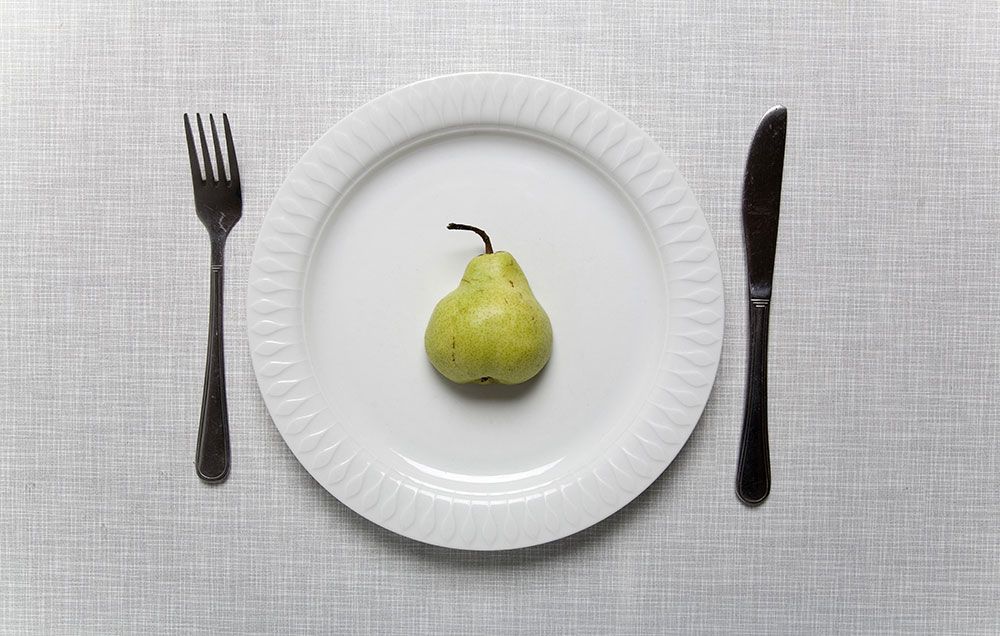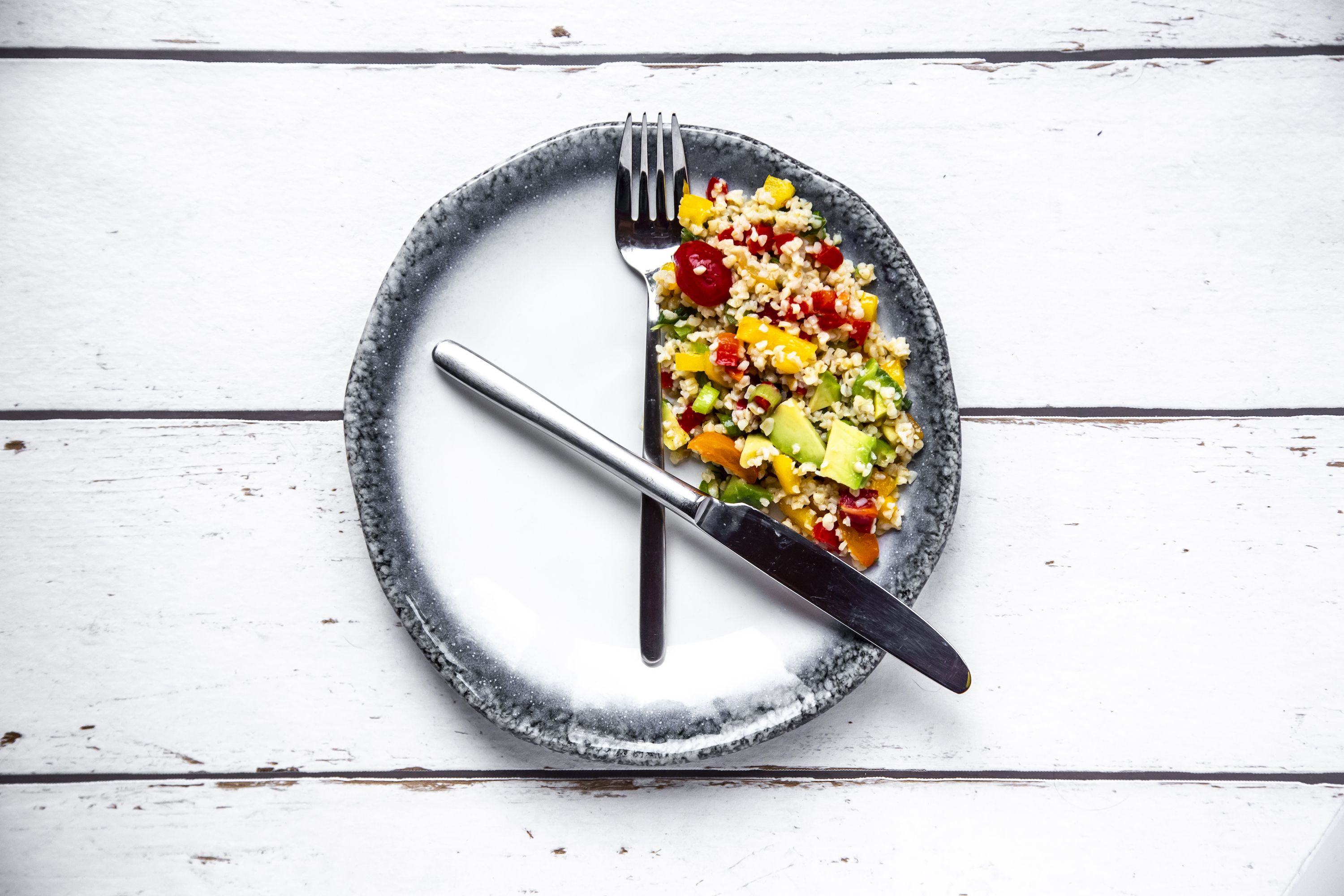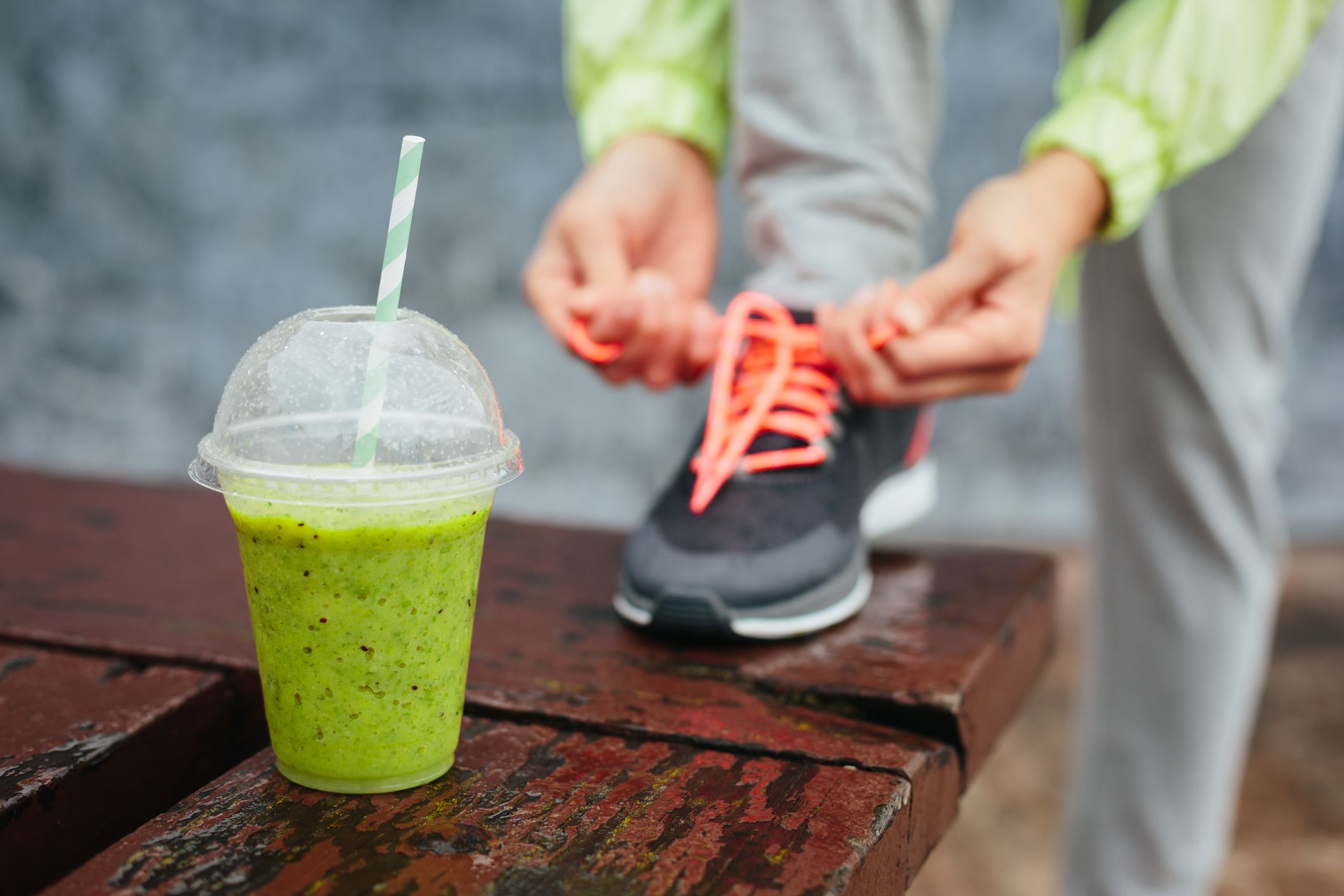Home » Diet & Food »
A Fasting Diet Shouldn't Turn You Into A Hangry Betch—Here's How To Do It Right
Let’s face it: Following a diet can be tough. Following one that involves fasting (yes, as in not eating)? Well, that can be even tougher. And for some (*raises hand*), just the idea of purposely missing a meal is enough to make them hangry, if not worse.
Yet, there are plenty of folks out there who are up for the challenge—not to mention have even seen some serious results from a structured and scheduled eating plan. So what’s the secret to their success? Following at least one—if not all!—of these 12 tips for acing a fasting diet, straight from nutritionists. But first…
Remind me again: What is intermittent fasting, exactly?
Essentially, intermittent fasting (IF) is a type of eating plan that involves periods of fasting—during which you can consume only water, coffee, and tea—and eating—when you can generally eat what you like. Such freedom to choose your own chow is one of the many reasons the diet’s racked up so many fans, including stars like Vanessa Hudgens and Halle Berry.
And in a world where many of the top trending diets involve a lot of, well, math, IF stands outs for being fairly simple to understand. “It doesn’t require counting calories, macros, or measuring ketones. You can eat most anything you want between a specific window of time, although most programs recommend eating healthfully when you do eat,” Sonya Angelone, RD, a spokeswoman for the Academy of Nutrition and Dietetics, previously told Women’s Health.
Need some IF inspo? Halle Berry is a huge fan—find out why and how she does it:
Another pro? There isn’t a one-size-fits-all plan or “right” way to do this, per Anglone. In fact, it’s just the opposite. There are many different kinds of fasting or IF schedules to choose from, so you can decide the diet that best fits your lifestyle. Here are a few popular picks:
- The 16:8 diet: Eat whatever you want (read: no calorie counting!) for eight hours a day and fast for the rest.
- The 5:2 diet: Eat normally for five days a week and cut back to 20 percent of your normal daily calories for the other two “fasting” days, which usually involves about 500 calories for women.
- The 14:10 diet: Similar to the 16:8 method, but you fast only 14 hours and eat for 10, making it easier to follow but not necessarily easier to lose weight.
And that, dear class readers, is Fasting 101. Now, onto lesson number two: the 12 must-know tips to do a fasting diet safely and successfully.
1. Ease into your new eating plan.
While it might be tempting to jump right into your new eating routine (the initial excitement is real), doing so can be difficult and leave you with increased hunger and discomfort, according to Michal Hertz, RD, a dietitian in New York City. Instead, she recommends starting slowly by, say, doing two to three days of IF during the first week and then “gradually increasing week to week.” Taking thing slow isn’t just a great fasting tip, but a great tip for life (just sayin’).
2. Know the difference between needing to eat and wanting to eat.
Once you hear your stomach growl, it can feel like there’s no way you’ll get through X more amount of hours without food. Tune in to that hunger cue. “Ask yourself whether the hunger is boredom or actual hunger,” says Eliza Savage, RD, a registered dietitian at Middleburg Nutrition in New York City. “If you’re bored, distract yourself with another task.” (That 200-email-deep inbox of yours might be a good place to start.)

If you’re truly hungry but not feeling weak or dizzy (which are signs, btw, that you should stop fasting ASAP), then sip a warm mint tea, as peppermint is known to reduce appetite, or drink water to help fill your stomach until your next meal, per Savage.
Now, if you’ve been trying IF for awhile and still feel extreme hunger between periods, then you need to do some thinking.”You need to either add more nutrient- or calorie-dense foods during your eight-hour period, or consider that this may not be the best plan for you,” Hertz says. Adding healthy fats such as nut butters, avocado, and coconut and olive oils, as well as proteins, during eating times can help keep you stay satisfied and full longer.
3. Eat when necessary.
Technically, intense hunger and fatigue shouldn’t happen when following the 16:8 fasting method (perhaps the most common one), according to Hertz. But if you do feel extremely lightheaded, listen up, as odds are your body’s trying to tell you something. You likely have low blood sugar and need to eat something—and, repeat after me, that is okay.
By definition, fasting involves removing some, if not all, food, so don’t beat yourself up for breaking your fast with small—and smart!—bites. Your best bet? Go for a protein-rich snack like a few slices of turkey breast or one to two hard-boiled eggs (to help remain in a ketogenic (fat-burning) state), Savage recommends. You can then return fasting, that is, of course, if you feel up to it.
4. Hydrate, hydrate, hydrate.
Even when you’re fasting, drinking water and bevvies like coffee and tea (sans milk) are not just allowed, but, especially in the case of H2O, encouraged, per Hertz.
She recommends setting reminders throughout the day and particularly during fasting periods to lap up plenty of liquids. Aim to fill up on at least 2, if not 3, liters per day, according to both Hertz and Savage.
5. Break your fast slowly and steadily.
After spending several hours food-free, you might feel like a human vacuum ready to suck up whatever’s on your plate. But chowing down in minutes is actually no bueno for your body or your waistline, according to research. Instead, you want to chew well and eat slowly to allow your digestive system to fully process the food, Savage explains. This will also help you have a better idea of your fullness so that you steer clear of overeating.
6. Avoid overeating.
On that note, just because you’ve stopped fasting doesn’t mean you should feast. Not only can eating too much leave you bloated and uncomfortable, but it can also sabotage the weight-loss goals that likely led you to IF in the first place. Simply put: It’s not necessarily how much is on your plate that can help you stay full for longer but what is on your plate. Which brings me to the next fasting tip…
7. Maintain balanced meals.
Having a hearty mixture of protein, fiber, healthy fats, and carbs can help you ultimately shed those pounds and steer clear of extreme hunger when fasting. A good example, per Savage? Grilled chicken(you want about 4 to 6 oz of protein) with half of a small sweet potato, and sautéed spinach with garlic and olive oil.
When it comes to fruits, you want to opt for those with “a low-glycemic index, which are more slowly digested, absorbed, and metabolized, causing a lower and slower rise in blood glucose,” Hertz explains. A stable blood-sugar level helps you avoid cravings—and thus is key when it comes to successfully dropping lbs.
8. Play around with different time periods.
While Hertz mostly recommends the 16:8, she says to a look at your general lifestyle to see which fasting method might fit best.

For example, if you’re an early riser, Hertz suggests eating during the earlier hours, like 10 a.m. to 6 p.m., and then fasting until the following morning at 10. Remember: The beauty of IF is that it’s easily amendable and flexible to fit you and your schedule.
Another option, according to Savage, is cutting yourself off earlier and eating breakfast later each day to gradually grow your fasting strength. “We all naturally fast once daily—while we sleep—so maybe you practice ‘shutting down the kitchen’ earlier.” For example, “close” the kitchen at 9 p.m., and then don’t eat again until breakfast at 8 am. That’s a natural 11-hour fast! Slowly move those times out (e.g. kitchen closes at 8 p.m., breakfast at 9 a.m.), if desired, she says.
9. Steer clear of 24-hour fasts.
Both experts do not recommend fasting for a full day, as it can “lead to increased weakness, hunger, and increased food consumption—and thus, weight gain,” Hertz explains.
If your goal is to lose weight, then considering your overall caloric intake and working on scaling that down might be more beneficial than toughing out a fast for a long time (especially if you’re the type to binge after). Just take it from research, which shows that there actually aren’t more benefits in fasting for 24 hours versus daily caloric restriction, Savage adds.
10. Adapt your workout routine.
First thing’s first: You can most definitely exercise if you’re doing a fasting diet. But (!!) you want to be mindful of what types of movement you do, and when. “If you’re choosing to exercise in a fasting state, I would recommend exercising first thing in the morning, when you may have the most energy,” Savage says.


That said, it’s important to remember that if you’re not, in Savage’s words, “adequately fueling your muscles,” then you’re at a greater risk of injury.So you might want to consider lower-impact workouts, such as yoga or steady-state cardio, on fasting mornings and save that hard-core HIIT class for after you’ve eaten.
11. Keep track of your journey.
Believe it or not, maintaining a food journal can help you with your fasting diet. A food journal for fasting?! Yup, you read that right. While you might not be chronicling as many eats, actively jotting down details like any emotions and symptoms (hunger level, any weakness, etc.) that come up during IF can help you gauge your progress, Savage says. (It might also help you notice any trigger points that make fasting harder on you, like drinking the night prior.)
12.Listen to your body.
This. Is. Important. Keep an eye out at all times for symptoms such as dizziness, fatigue, (unusual) irritability, headache, anxiety, and difficulty concentrating. If you experience any of these, consider breaking your fast. “These are all signs that the body is going into starvation mode and may need nourishment,” Savage says. And if you start to feel colder than normal, that is even more of a sign to stop fasting, she adds.
That said, be patient. It’ll likely take your body time to get used to fasting, and you may feel hungrier and weaker than usual. So don’t flip out if you have these (less serious) sensations for a week or so. If these challenges last longer, however, and you experience symptoms like the ones above dizziness, Savage recommends ditching the diet and finding something else to help you meet your goals. No amount of pounds is worth getting sick over—trust.
Source: Read Full Article



